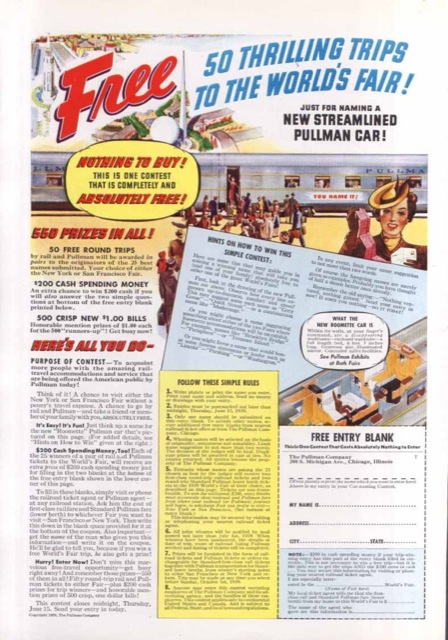Pullman was the dominant passenger car manufacturer in the first half of the twentieth century, and it had a near-monopoly on sleeping car operations. This booklet describing the Pullman exhibit at the 1939 New York World’s Fair reveals how such monopoly power stifles innovations and creativity.

Click image to download a 12.8-MB PDF of this 20-page brochure.
Pullman had six cars on display at the fair. Despite the fact that the fair was a full five years after the introduction of the M-10000 and Zephyr at the 1934 Chicago Century of Progress fair, only three of the six cars are streamlined. Two of the non-streamlined cars have traditional sections, which dated back, with only minor improvements, to the first Pullman cars more than half a century before. This completely ignored the increasing preference for sleeping rooms instead of open berths.
The third non-streamlined car was a special lounge car with the sides cut out so that actors could take part in a “Railroads on Parade” pageant. The car had smooth, instead of riveted, sides, but its roof profile matched many heavyweight cars. It was probably an older car with a new outside veneer. This backwards-looking car fit right in with the pageant, which climaxed with several large streamlined steam locomotives, a technology whose time was already past thanks to General Motors Diesels.
The premiere car at the Pullman exhibit was a streamlined observation-lounge car dubbed the “Car of Tomorrow.” More like the car of six years before: Pullman had displayed a similar-looking, all-aluminum car, named the George M. Pullman, at the Chicago Century of Progress fair. The 1933 car had rivets so it wasn’t quite as streamlined, but was lighter in weight and had similar interior features to the 1939 car. In 1936, Pullman built a streamlined car called Progress that was nearly identical to the Car of Tomorrow (except that it was part of a two-car articulated set).

This Pullman ad from the May 22, 1939, Time magazine invites readers to suggest a name for the roomette car. Click image for a larger view.
The most modern car on display was a streamlined car with roomettes, a room concept that Pullman had introduced in June, 1937. Pullman charged about 40 percent more for a roomette than a lower berth in a section, which made sense as it could squeeze 28 beds in an all-section car but only 18 in the roomette car.
The third streamlined car at the fair had five bedrooms and twelve “duplex rooms,” rooms that were staggered three steps up and down so that a few more beds could be fit into the car. Pullman had begun experimenting with duplex rooms, in which people slept perpendicular to the direction of travel, in 1931, but they never proved popular. Instead, in 1942, Pullman introduced the duplex roomette, similarly staggered but in which people slept parallel to the direction of travel. The company could fit 24 beds in a duplex roomette car, which made it more attractive than ordinary roomettes.
All in all, Pullman made it clear that it would respond to the challenge of Budd’s stainless steel, lightweight Zephyrs and other trains by using its monopoly over sleeping car operations rather than by keeping up with Budd’s styles and innovative technology. That worked fine–until the government brought an anti-trust lawsuit against the company in 1940, which resulted in a court-ordered break-up of the company into a manufacturer and an operating company in 1944.
